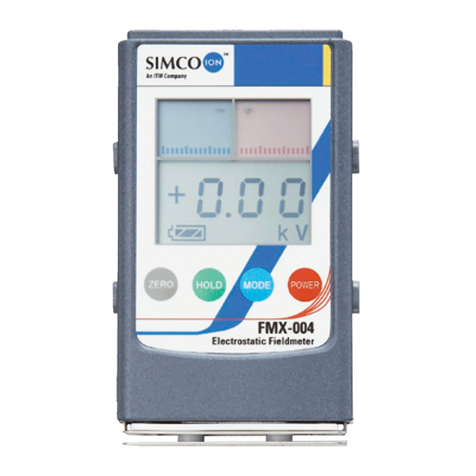
55201226 Rev. F
IQ Easy Sensor Bar
4. INSTALLATION
Unpacking
Carefully remove all equipment from its carton and inspect the contents:
• Check that the details on the packing slip correspond to the details of the
product received.
• Check that the equipment is free from damage.
• If any damage has occurred during shipment, notify the local carrier
at once. A report should also be forwarded to Simco-Ion, 2257 North
Penn Road, Hatfield, PA 19440. See Section 9 of this manual for Return
Shipment information.
Mechanical Installation
NOTE –
Conductive machine parts or a static neutralizing bar in the vicinity
of the static sensor bar have an undesired influence on its operation. For
optimum results, the static sensor bar must be installed as per Figure 4.
1. Downstream of the static neutralizing bar, at a minimum distance of 12” (300
mm) so that any electric fields from the static neutralizing bar will not interfere
with charge measurement.
Downstream of the charging bar (where used in static charge generation
monitoring), at an absolute minimum distance of 12” (300 mm), greater
distances are preferred, as installation allows. So that electric fields from the
static charging bar will not interfere with charge measurement.
2. At an optimum distance from the material to be measured. The mounting
distance is related to the maximum static charge anticipated. The higher the
anticipated charge, the further the sensor bar should be mounted from the
material. The factory default mounting distance of 4” (100 mm) will provide
an operating range of +/-30 kV.
Other operating distances and maximum operating ranges are:
• 2” (50 mm) 20 kV
• 3” (75 mm) 25 kV
• 4” (100 mm) 30 kV (factory default setting)
• 6” (150 mm) 40 kV
• 8” (200 mm) 50 kV
• 10” (250 mm) 60 kV
NOTE –
Calibration of the static sensor bar is distance dependent. If a
distance other than the factory default setting is used, the Mounting
Distance setting will need to be changed at the IQ Power Control Station.
3. Sensors must face the material to be measured, perpendicular to surface.
4. DO NOT mount the bar over a roller or where the material to be neutralized is
in contact with any other surface.
































